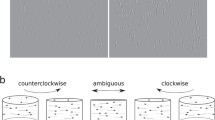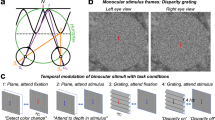Abstract
We propose a novel depth perception model to determine the time taken by the human visual system (HVS) to adapt to an abrupt change in stereoscopic disparity, such as can occur in a scene cut. A series of carefully designed perceptual experiments on successive disparity contrast were used to build our model. Factors such as disparity, changes in disparity, and the spatial frequency of luminance contrast were taken into account. We further give a computational method to predict the response time during scene cuts in stereoscopic cinematography, which has been validated in user studies. We also consider various applications of our model.













Similar content being viewed by others
References
Akeley, K., Watt, S.J., Girshick, A.R., Banks, M.S.: A stereo display prototype with multiple focal distances. ACM Trans. Graph. 23(3), 804–813 (2004)
Basha, T., Moses, Y., Avidan, S.: Geometrically Consistent Stereo Seam Carving. In: ICCV, pp. 1816–1823 (2011)
Burt, P., Julesz, B.: A disparity gradient limit for binocular fusion. Science 208, 615–617 (1980)
Celikcan, U., Cimen, G., Kevinc, E.B., Capin, T.: Attention-aware disparity control in interactive environments. Vis. Comput. 29(6–8), 685–694 (2013)
Chang, C.H., Liang, C.K., Chuang, Y.Y.: Content-aware display adaptation and interactive editing for stereoscopic images. IEEE Trans. Multimedia 13(4), 589–601 (2011)
Cheng, M.M., Zhang, G.X., Mitra, N.J., Huang, X., Hu, S.M.: Global Contrast Based Salient Region Detection. In: IEEE CVPR, pp. 409–416 (2011)
Choi, J., Kim, D., Choi, S., Sohn, K.: Visual fatigue modeling and analysis for stereoscopic video. Opt. Eng. 51(1), 017206-1–017206–11 (2012)
Choi, J., Kim, D., Ham, B., Choi, S., Sohn, K.: Visual Fatigue Evaluation and Enhancement for 2d-plus-depth Video. In: IEEE ICIP, pp. 2981–2984 (2010)
Cumming, B.G., Judge, S.J.: Disparity-induced and blur-induced convergence eye movement and accommodation in the monkey. J. Neurophysiol. 55(5), 896–914 (1986)
Dahan, M.J., Chen, N., Shamir, A., Cohen-Or, D.: Combining color and depth for enhanced image segmentation and retargeting. Vis. Comput. 28(12), 1181–1193 (2012)
Didyk, P., Ritschel, T., Eisemann, E., Myszkowski, K., Seidel, H.P.: A perceptual model for disparity. ACM Trans. Graph. 30(4), 96:1–96:10 (2011)
Didyk, P., Ritschel, T., Eisemann, E., Myszkowski, K., Seidel, H.P., Matusik, W.: A luminance-contrast-aware disparity model and applications. ACM Trans. Graph. 31(6), 184:1–184:10 (2012)
Du, S.P., Hu, S.M., Martin, R.: Changing perspective in stereoscopic images. IEEE Trans. Vis. Comput. Graph. 19(8), 1288–1297 (2013)
Du, S.P., Masia, B., Hu, S.M., Gutierrez, D.: A metric of visual comfort for stereoscopic motion. ACM Trans. Graph. 32(6), 222:1–222:9 (2013)
Emoto, M., Niida, T., Okano, F.: Repeated vergence adaptation causes the decline of visual functions in watching stereoscopic television. J. Disp. Technol. 1(2), 328–340 (2005)
Erkelens, C.J., Regan, D.: Human ocular vergence movements induced by changing size and disparity. J. Physiol. 379, 145–169 (1986)
Erkelens, C.J., Steinman, R.M., Collewijn, H.: Ocular vergence under natural conditions. II. Gaze shifts between real targets differing in distance and direction. Proceedings of the Royal Society of London. Series B, Containing papers of a Biological character. R Soc (Great Britain) 236(1285), 441–465 (1989)
Heinzle, S., Greisen, P., Gallup, D., Chen, C., Saner, D., Smolic, A., Burg, A., Matusik, W., Gross, M.: Computational stereo camera system with programmable control loop. ACM Trans. Graph. 30(4), 94:1–94:10 (2011)
Hess, R.F., Kingdom, F.A., Ziegler, L.R.: On the relationship between the spatial channels for luminance and disparity processing. Vis. Res. 39(3), 559–568 (1999)
Hoffman, D.M., Girshick, A.R., Akeley, K., Banks, M.S.: Vergence-accommodation conflicts hinder visual performance and cause visual fatigue. J. Vis. 8(3), 33:1–33:30 (2008)
Howard, I.P., Rogers, B.J.: Perceiving in Depth. Volume 2: Stereoscopic Vision. Oxford University Press, Oxford (2012)
Hu, S.M., Chen, T., Xu, K., Cheng, M.M., Martin, R.R.: Internet visual media processing: a survey with graphics and vision applications. Vis. Comput. 29(5), 393–405 (2013)
Hulusic, V., Debattista, K., Chalmers, A.: Smoothness perception. Vis. Comput. 29(11), 1159–1172 (2013)
Ide, S., Yamanoue, H., Okui, M., Okano, F., Bitou, M., Terashima, N.: Parallax distribution for ease of viewing in stereoscopic hdtv. SPIE 4660, 38–45 (2002)
Inoue, T., Ohzu, H.: Accommodative responses to stereoscopic three-dimensional display. Appl. Opt. 36(19), 4509–4515 (1997)
Kim, D., Sohn, K.: Visual fatigue prediction for stereoscopic image. IEEE Trans. Circ. Syst. Video Technol. 21(2), 231–236 (2011)
Lambooij, M.T.M., IJsselsteijn, W.A., Heynderickx, I.: Visual discomfort and visual fatigue of stereoscopic displays: a review. J. Imaging Technol. Sci. 53(3), 1–14 (2009)
Lang, M., Hornung, A., Wang, O., Poulakos, S., Smolic, A., Gross, M.: Nonlinear disparity mapping for stereoscopic 3d. ACM Trans. Graph. 29(4), 75:1–75:10 (2010)
Lee, B., Rogers, B.: Disparity modulation sensitivity for narrow-band-filtered stereograms. Vis. Res. 37(13), 1769–1777 (1997)
Lee, K.Y., Chung, C.D., Chuang, Y.Y.: Scene warping: layer-based stereoscopic image resizing. In: IEEE CVPR, pp. 49–56 (2012)
Lee, S., Kim, Y., Lee, J., Kim, K., Lee, K., Noh, J.: Depth manipulation using disparity histogram analysis for stereoscopic 3d. Vis. Comput. 30(4), 455–465 (2014)
Liao, M., Gao, J., Yang, R., Gong, M.: Video stereolization: combining motion analysis with user interaction. IEEE Trans. Vis. Comput. Graph. 18(7), 1079–1088 (2012)
Liu, C.W., Huang, T.H., Chang, M.H., Lee, K.Y., Liang, C.K., Chuang, Y.Y.: 3d cinematography principles and their applications to stereoscopic media processing. In: ACM Multimedia, pp. 253–262 (2011)
Lo, W.Y., van Baar, J., Knaus, C., Zwicker, M., Gross, M.: Stereoscopic 3d copy and paste. ACM Trans. Graph. 29(6), 147:1–147:10 (2010)
Luo, S.J., Shen, I.C., Chen, B.Y., Cheng, W.H., Chuang, Y.Y.: Perspective-aware warping for seamless stereoscopic image cloning. ACM Trans. Graph. 31(6), 182:1–182:8 (2012)
Marr, D., Poggio, T.: A computational theory of human stereo vision. Proceedings of the Royal Society of London. Ser B Biol Sci 204(1156), 301–328 (1979)
Masia, B., Wetzstein, G., Aliaga, C., Raskar, R., Gutierrez, D.: Display adaptive 3d content remapping. Comput. Graph. 37(8), 983–996 (2013)
Mendiburu, B.: 3D Movie Making: Stereoscopic Digital Cinema from Script to Screen. Focal Press, England (2009)
Mu, T.J., Wang, J.H., Du, S.P., Hu, S.M.: Stereoscopic image completion and depth recovery. Vis. Comput. 30(6–8), 833–843 (2014)
Neri, P., Bridge, H., Heeger, D.J.: Stereoscopic processing of absolute and relative disparity in human visual cortex. J. Neurophysiol. 92(3), 1880–1891 (2004)
Niu, Y., Feng, W.C., Liu, F.: Enabling warping on stereoscopic images. ACM Trans. Graph. 31(6), 183:1–183:7 (2012)
Oskam, T., Hornung, A., Bowles, H., Mitchell, K., Gross, M.: Oscam—optimized stereoscopic camera control for interactive 3d. ACM Trans. Graph. 30(6), 189:1–189:8 (2011)
Palmer, S.E.: Vision Science: Photons to Phenomenology. The MIT Press, Cambridge (1999)
Pan, B., Zhao, Y., Guo, X., Chen, X., Chen, W., Peng, Q.: Perception-motivated visualization for 3d city scenes. Vis. Comput. 29(4), 277–289 (2013)
Pollock, B., Burton, M., Kelly, J., Gilbert, S., Winer, E.: The right view from the wrong location: depth perception in stereoscopic multi-user virtual environments. IEEE Trans. Vis. Comput. Graph. 18(4), 581–588 (2012)
Rashbass, C., Westheimer, G.: Disjunctive eye movements. J. Physiol. 159(2), 339–360 (1961)
Schor, C.M.: A dynamic model of cross-coupling between accommodation and convergence: simulations of step and frequency responses. Optom. Vis. Sci. 69(4), 258–269 (1992)
Schor, C.M.: The influence of interactions between accommodation and convergence on the lag of accommodation. Ophthal. Physiol. Opt. 19(2), 134–150 (1999)
Schor, C.M., Kotulak, J.C.: Dynamic interactions between accommodation and convergence are velocity sensitive. Vis. Res. 26(6), 927–942 (1986)
Shibata, T., Kim, J., Hoffman, D.M., Banks, M.S.: The zone of comfort: predicting visual discomfort with stereo displays. J. Vis. 11(8), 11:1–11:29 (2011)
Smith, B.M., Li, Z., Jin, H.: Stereo Matching with Nonparametric Smoothness Priors in Feature Space. In: IEEE CVPR, pp. 485–492 (2009)
Takagi, M., Oyamada, H., Abe, H., Zee, D.S., Hasebe, H., Miki, A., Usui, T., Bando, T.: Adaptive changes in dynamic properties of human disparity-induced vergence. Invest. Ophthalmol. Vis. Sci. 42(7), 1479–1486 (2001)
Tong, R.F., Zhang, Y., Cheng, K.L.: Stereopasting: interactive composition in stereoscopic images. IEEE Trans. Vis. Comput. Graph. 19(8), 1375–1385 (2013)
Yang, S., Gowrisankaran, S., Younkin, A.C., Corriveau, P.J., Sheedy, J.E., Hayes, J.R.: Discernible difference and change in object depth afforded by stereoscopic three-dimensional content. In: SPIE, vol. 8648, pp. 86481C–86481C–11 (2013)
Yong, J.J., Lee, S.I., Sohn, H., Hyun, W.P., Yong, M.R.: Visual comfort assessment metric based on salient object motion information in stereoscopic video. J. Electron. Imaging 21(1), 011008-1–011008-16 (2012)
Zhang, G., Hua, W., Qin, X., Wong, T.T., Bao, H.: Stereoscopic video synthesis from a monocular video. IEEE Trans. Vis. Comput. Graph. 13(4), 686–696 (2007)
Acknowledgments
We would like to thank the anonymous reviewers for their insightful comments. This work was supported by the National Basic Research Project of China (No. 2011CB302205), the Natural Science Foundation of China (No. 61272226 and 61120106007), the National High Technology Research and Development Program of China (No. 2013AA013903) and Tsinghua University Initiative Scientific Research Program.
Author information
Authors and Affiliations
Corresponding author
Rights and permissions
About this article
Cite this article
Mu, TJ., Sun, JJ., Martin, R.R. et al. A response time model for abrupt changes in binocular disparity. Vis Comput 31, 675–687 (2015). https://doi.org/10.1007/s00371-014-0994-6
Published:
Issue Date:
DOI: https://doi.org/10.1007/s00371-014-0994-6




